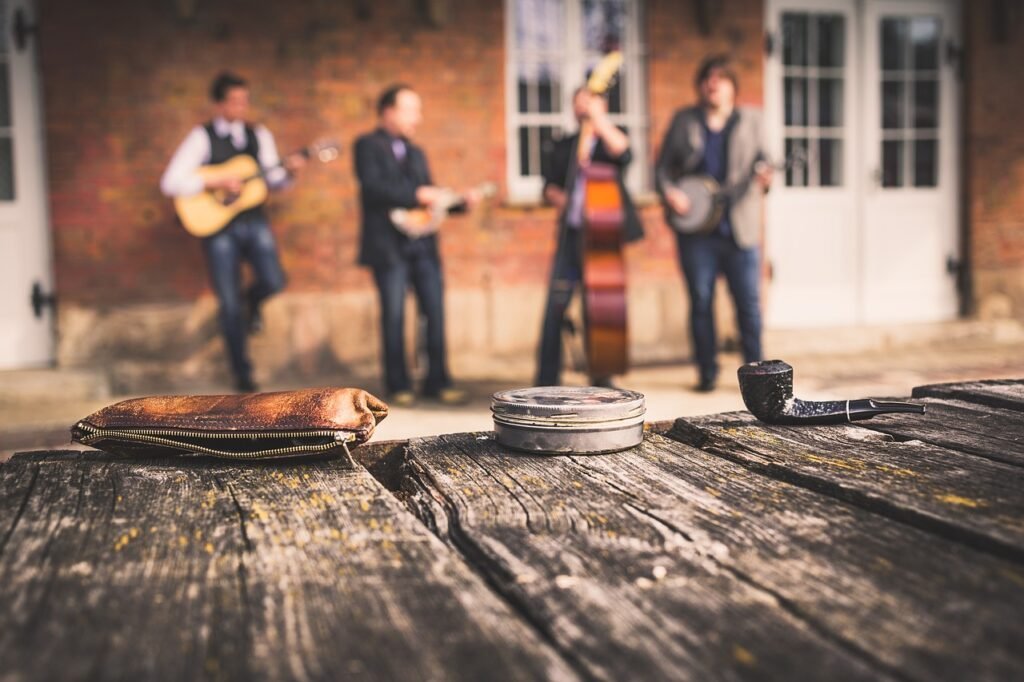Introduction to Bluegrass Music
bluegrass instrument nyt music, with its roots deeply embedded in the Appalachian region of the United States, is a genre that combines elements of old-time music, country, and jazz, creating a distinctive and vibrant sound. Originating in the mid-1940s, bluegrass music was pioneered by Bill Monroe and his band, the Blue Grass Boys, from which the genre gets its name. This musical style quickly gained popularity and became a cultural staple in the rural communities of the American South.
The origins of bluegrass are deeply intertwined with the history and culture of the Appalachian Mountains. Immigrants from the British Isles brought their ballads, reels, and folk songs to this region, contributing to the development of a unique musical tradition. Over time, bluegrass evolved, incorporating African American musical influences, such as blues and jazz, which enriched its harmonic and rhythmic complexity. This fusion of diverse musical traditions gave birth to a genre characterized by its fast tempo, virtuosic instrumentals, and tight, three-part vocal harmonies.
One of the most defining features of bluegrass music is its instrumental ensemble. Traditional bluegrass bands consist of an array of acoustic instruments, including the banjo, fiddle, mandolin, guitar, and double bass. Each instrument plays a crucial role in building the genre’s characteristic sound, which is marked by intricate melodies and spontaneous improvisations. The use of the bluegrass instrument, like the banjo, often stands out thanks to its rapid, syncopated picking patterns, creating a lively and energetic atmosphere.
Moreover, bluegrass music’s hallmark is its improvisational nature. During performances, musicians frequently engage in “breakdowns” or solos, showcasing their technical prowess and creativity. This aspect of bluegrass not only highlights individual talent but also fosters a dynamic interplay between band members, which is a central element of the genre’s appeal.
Throughout the decades, bluegrass has continually adapted and evolved, giving rise to various subgenres and modern interpretations. Today, it remains a vital and influential genre, celebrated for its rich history and ongoing contributions to the broader landscape of American music.
The Role of the Banjo in Bluegrass
The banjo occupies an irreplaceable position within the bluegrass genre, serving as both a rhythmic and melodic cornerstone. This stringed instrument, characterized by its distinct twang, has roots extending back to African musical traditions, but it found its current form and status in American folk and bluegrass music. Originating in the 18th century, the banjo initially featured a gourd body and a fretless neck, but evolved to include a resonator and metal strings by the 20th century, allowing it to produce its signature sparkling sound.
Playing the banjo in bluegrass settings typically involves a three-finger picking style, also known as Scruggs style, named after the legendary Earl Scruggs. This technique brings a lively and intricate sound that complements the fast tempo of bluegrass music. Additionally, clawhammer style, another prevalent way of playing, employs a different hand motion to create rhythmic drive and percussive elements, offering a contrasting texture that enriches this genre.
The banjo’s bright and bold sound often leads the melody or provides counter-melodies that interact dynamically with other instruments. Its versatility enables it to fill a variety of roles, from carrying the main tune to layering complex rolls and riffs. Renowned banjo players such as Bill Keith, known for introducing melodic style picking, and Bela Fleck, celebrated for his eclectic and boundary-expanding approach, have tremendously shaped and broadened the role of the banjo within and beyond bluegrass.
Through its rich history and distinctive sound characteristics, the banjo continues to be a focal point in the genre. Influential banjoists have not only pushed technical and creative boundaries but have also ensured that this instrument remains integral to the ongoing evolution of bluegrass music. This enduring appeal is reflected in its frequent appearances in various genres and media, including its notable mentions and features as the “bluegrass instrument nyt” and beyond, attesting to its cultural significance and perpetual fascination.
Guitar: The Rhythm Backbone

The guitar holds a pivotal role in bluegrass music, serving as the rhythmic cornerstone of the ensemble. Its function transcends mere accompaniment, providing a solid foundation upon which the melodies of other instruments can build and flourish. The typical bluegrass ensemble relies heavily on the guitar’s steady rhythm, ensuring cohesion and synchrony within the group.
Central to the guitar’s role in bluegrass is the use of flat-top acoustic guitars. These instruments are favored due to their strong, resonant sound, which is capable of cutting through the mix of banjos, fiddles, and mandolins. Unlike electric guitars, the natural acoustic quality of flat-top guitars complements the organic, earthy aesthetic of bluegrass. Techniques such as flatpicking and fingerstyle play a crucial role in eliciting the signature sound associated with bluegrass guitar. Flatpicking involves using a pick to play individual notes in rapid succession, creating a lively and dynamic rhythm, while fingerstyle offers a more intricate and textured approach, layering melody and harmony.
In the realm of bluegrass instrument differences, the guitar stands out due to its versatility and expressive potential. Notable bluegrass guitarists, such as Tony Rice and Doc Watson, have pushed the boundaries of what the guitar can achieve within this genre. Tony Rice, known for his fluid flatpicking and innovative techniques, has left an indelible mark on the bluegrass world. Similarly, Doc Watson’s virtuosity and profound influence have shaped the way the guitar is perceived and played in bluegrass circles.
Through its enduring presence and versatility, the guitar remains an indispensable component of bluegrass music. Its rhythmic authority and capacity to blend harmonic layers contribute significantly to the genre’s distinctive sound, making it a revered bluegrass instrument in every sense of the term.
Mandolin: The High-Pitched Melody Maker

The mandolin holds a significant place in the world of bluegrass music, often serving as both a rhythm and lead instrument. Characterized by its bright, percussive sound, the mandolin’s unique timbre complements other bluegrass instruments, enriching the overall ensemble with high-pitched melodies and driving rhythms. Its sharp, resonant notes cut through the mix, allowing it to stand out even amidst a cacophony of other stringed instruments.
The standard bluegrass mandolin is typically equipped with eight strings, paired into four sets of two, which are tuned in unison. This setup allows players to produce a fuller, more vibrant sound compared to single-string instruments. Techniques like tremolo, chopping, and double stops are frequently employed to create the distinctive rhythmic patterns and melodic runs that embellish bluegrass performances.
The mandolin’s ability to switch roles seamlessly—from providing rhythmic “chops” during verses to taking center stage with intricate solos in instrumental breaks—is one of its defining features in bluegrass music. This versatility is brought to life through the styles and techniques used by iconic mandolinists such as Bill Monroe, often regarded as the father of bluegrass music. Monroe’s explosive and expressive playing style set a new standard for mandolinists, with his fast-paced, driving melodies forming the backbone of many classic bluegrass tunes.
Other notable mandolin players like Ricky Skaggs, Sam Bush, and Chris Thile have continued to shape and expand the mandolin’s role in bluegrass. Each has brought their unique touch, further diversifying the instrument’s contribution to the genre. Skaggs, known for his precise yet soulful playing, has seamlessly integrated traditional elements with innovative techniques. Meanwhile, Bush’s progressive approach and Thile’s virtuosic flair have pushed the boundaries of what the mandolin can achieve in bluegrass, cementing its place as an indispensable component of the bluegrass soundscape.
The Importance of the Fiddle
The fiddle holds an esteemed place within the realm of bluegrass music, often being considered the soul of a bluegrass ensemble. Its rich, expressive sound profoundly adds to the emotional depth of the genre, providing a distinct charm that is both lively and moving. Drawing from folk traditions, the bluegrass fiddle is characterized by its ability to convey heartfelt emotion through intricate melodies and rhythmic patterns, resonating with audiences at a profound level.
In bluegrass music, fiddling techniques vary considerably, lending each performance a unique texture. Common techniques include the shuffle bowing pattern, where the bow moves back and forth in a rhythmic manner; double stops, where two strings are played simultaneously to create harmonic complexity; and slides, which offer an expressive quality as notes are seamlessly connected. Such techniques contribute to the distinctive sound of bluegrass and showcase the fiddler’s dexterity and creativity.
Different styles of fiddling have evolved over time, reflecting regional influences and individual artistry. Traditional Appalachian fiddling, for instance, emphasizes rhythmic bowing patterns and drones, capturing the raw essence of early American folk music. Conversely, more contemporary styles, influenced by jazz and classical music, bring technical precision and sophisticated improvisation to the forefront. These variations enrich the bluegrass landscape, ensuring its continued evolution and appeal.
Throughout bluegrass history, numerous fiddlers have achieved legendary status, leaving an indelible mark on the genre. Pioneers such as Bill Monroe’s longtime collaborator, Kenny Baker, are celebrated for their innovative approaches and virtuosic performances. More recent icons like Stuart Duncan have pushed the boundaries of traditional bluegrass, infusing it with modern sensibilities. Their contributions not only highlight the fiddle’s central role but also inspire future generations of musicians to explore and expand upon established traditions.
In essence, the fiddle’s significance in bluegrass music cannot be overstated. Its ability to blend technical prowess with emotional resonance ensures its place as a cornerstone of bluegrass instrumentation, captivating listeners and preserving the genre’s enduring legacy.
Upright Bass: The Foundational Groove
The upright bass, also known as the double bass, holds a pivotal role in bluegrass ensembles, serving as the cornerstone of the genre’s rhythm section. Its deep, resonant tones provide a sturdy bedrock upon which other instruments build their melodies and harmonies. Acting as the primary timekeeper, the upright bass establishes the tempo and groove, ensuring the ensemble’s cohesiveness and driving the music forward.
A key component of the upright bass’s contribution to bluegrass music is its distinctive playing techniques. One of the most recognizable methods is “slapping,” where the bassist plucks the strings and simultaneously strikes the fingerboard, creating a percussive sound that reinforces the rhythm. This technique not only adds a rhythmic element but also enhances the overall texture of the music.
Another essential technique is “bowing,” although less common in bluegrass compared to classical genres. Bowing involves using a bow to sustain notes and create expressive phrases, adding a unique character and melodic quality to the music. While not as prevalent as other methods, it provides a dynamic range that enriches the ensemble’s sound.
Several notable bassists have left an indelible mark on the world of bluegrass. Marshall Wilborn, for instance, is renowned for his impeccable timing and intricate bass lines, contributing significantly to the genre’s development. His work with bands like the Lynn Morris Band and the Johnson Mountain Boys showcases the vital role of the upright bass in bluegrass. Another influential figure is Mike Bub, whose tenure with the Del McCoury Band highlights his exceptional slap-bass technique and rhythmic precision, exemplifying the upright bass’s integral role in this musical style.
In understanding the bluegrass instrument’s impact, particularly the upright bass, one appreciates the foundational groove it provides. Whether through slapping or bowing, the upright bass ensures that bluegrass music retains its lively, toe-tapping essence, showcasing the versatility and importance of this remarkable instrument.
Dobro: The Resonator Guitar
The dobro, or resonator guitar, holds a distinctive place in the realm of bluegrass music, celebrated for its unique sound that sets it apart from traditional acoustic guitars. Unlike conventional guitars, the dobro features a metal resonator cone inside its body, which amplifies its string vibrations, resulting in a rich, metallic sound. This characteristic timbre is often described as bright and full, contributing a resonant depth to bluegrass ensembles.
One of the hallmark attributes of the dobro is the variety of techniques used to elicit its unique sound. Slide playing, where a player uses a metal or glass slide on the strings, creates a glissando effect, producing smooth, fluid notes that can mimic the human voice. This method is frequently utilized in bluegrass to provide a haunting, emotional quality to the music. Fingerpicking is another prevalent technique, where individual strings are plucked with the fingers, allowing for intricate, melodic patterns and rapid fire sequences that add dynamism to bluegrass compositions.
Throughout history, several dobro players have made significant contributions to bluegrass music. Josh Graves, often credited with bringing the dobro to prominence in bluegrass, introduced the resonator guitar to the genre through his work with Flatt and Scruggs in the mid-20th century. His innovative style and slide techniques left an indelible mark on the instrument’s early development. More recently, Jerry Douglas has elevated the status of the dobro, renowned for his virtuosic musicianship and collaborations with artists like Alison Krauss and Union Station. His groundbreaking approach and technical prowess continue to inspire and shape modern bluegrass sounds.
In the bluegrass instrument genre, few items command the unique sonic presence of the dobro. Its resonant, metallic tones and the expressive potential afforded by slide and fingerpicking techniques set it apart. The impact of legendary players underscores the dobro’s essential role in the vibrant tapestry of bluegrass music.
Jamming and Improvisation in Bluegrass
Bluegrass music is not just a collection of songs; it is an immersive cultural experience deeply rooted in community and tradition. Central to this culture is the practice of jamming and improvisation, a cornerstone that sets bluegrass apart from many other musical genres. Musicians often come together, creating impromptu sessions where the spontaneity of live performance comes to the fore. These sessions, whether in informal living room settings or larger gatherings at bluegrass festivals, act as both social events and learning environments.
In the world of bluegrass, jamming provides a unique platform for musicians to interact on an intimate level. Through these spontaneous collaborations, players share ideas, techniques, and sometimes even form lifelong friendships. The social aspect is vital, fostering a sense of community that transcends just the music itself. Newcomers and veterans alike are welcomed into the fold, creating a dynamic environment where innovation and tradition coexist.
One of the unwritten rules guiding these sessions is the principle of “playing it by ear.” Unlike classical music which relies heavily on sheet music, bluegrass musicians rely on their ability to listen and respond in real time. This requires not only technical prowess but also a keen sense of musical conversation. Each participant has a role to play, and respectful listening is paramount. Musicians take turns leading and following, allowing everyone a moment in the spotlight while maintaining the cohesive sound that defines bluegrass.
The importance of improvisation in bluegrass cannot be overstated. It enables musicians to infuse their unique personal expression into each performance. Whether playing a classic tune or a contemporary piece, the inclusion of improvised solos and variations ensures that no two performances are ever alike. This element of unpredictability keeps the genre fresh and engaging for both players and audiences alike. Mastering this skill is often considered a rite of passage, marking a musician’s evolution from novice to adept performer in the tradition of bluegrass instrument mastery.


